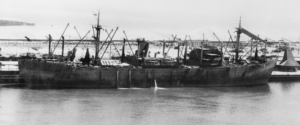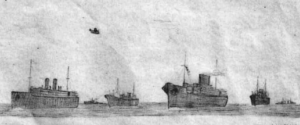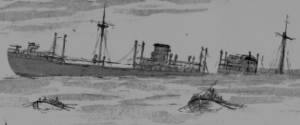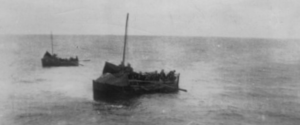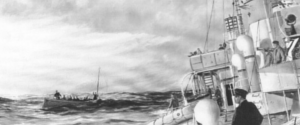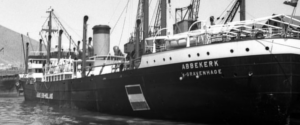The Clyde, Glasgow, at anchor

Abbekerk has delivered her cargo at Liverpool then sails to Glasgow and anchors in one of the sheltered bays of The Clyde, awaiting her next voyage. Now repairs, needed after half a year voyage, are conducted.
Looking at the ship it’s hard to imagine that she’s one of the most modern and fastest freighters in the world. In the 2 years of sailing during the war not much attention has been paid to her looks: the ship has been painted in a camouflage pattern in different shades of grey, but in the meantime a rusty brown has started to become a pretty dominant color even though the ship isn’t even 3 years old.
Build in Danzig, commissioned by the United Dutch Shipping Company (VNS : Verenigde Nederlandse Scheepvaartmaatschappij) Abbekerk was the second of three ships build for the Australian shipping routes. At a time where steam- and turbine engines are the most used engines in freighters, Abbekerk has 2 large 10 cylinder Sulzer diesel engines.Each supplying 11.000 HP and that gives her a cruising speed of no less than 17 knots (32 km/uur). A speed only surpassed by modern passenger- and war ships. During the trial run in 1939 she even achieved 22 knots (40 km/uur). She has five large holds equipped with cargo booms and electric winches. Next to that there are 12 luxury passenger accommodations.
Not only her worn looks stand out. On either sides of her masts slides with rafts are fitted, fast to launch by just cutting a rope. On the rear of the ship a cannon is clearly visible. It dates from the First World and fires 4 inch shells. The idea behind the canon is that it can be used to force a surfacing U-boat to retreat under water where its speed will become so low Abbekerk will be able to escape easily.
After The Netherlands capitulated most of her Merchant Navy started sailing for the allied war effort. And so did Abbekerk. In the past 2 years she already has been attacked by German planes twice. In London she was hit by several bombs during the first nights of the Blitz and was sunk in the Royal Docks. Later she was raised, repaired and back in service half a year later in april 1941.
 Adriaan Willem Kik (22) boarded the ship in 1939 to gather practical experience as part of his ship engineer studies. But no amount of training could prepare a man for what he and the rest of the crew had faced the past two years:
Adriaan Willem Kik (22) boarded the ship in 1939 to gather practical experience as part of his ship engineer studies. But no amount of training could prepare a man for what he and the rest of the crew had faced the past two years:
In fact we were totally unprepared and untrained for the task we were ordered to perform against a perfectly well trained and prepared enemy that could strike, undetected, at any second we were at sea. And very often did so ! Working in the engine room, meters below sea level, knowing a torpedo can strike any second is nerve-racking. I do remember that, at the end of our watch, we were dead tired and drank lots of water to moisten our dry mouths. Ass. Engineer Adriaan Kik

